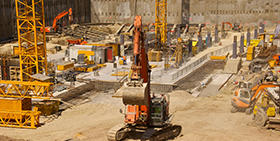The local sector of construction

While public infrastructure construction is at least the last 10 years, the residential sector is experiencing a rather accelerated recovery
In order to draft this study, we considered all the sectors that are directly involved in the construction activities, regarding the residential area, public infrastructure, recurrent maintenance or related activities (sanitary installations, electrical installations, painting, coating, window assembly, carpentry and woodwork, etc.). Thus, the sample comprises 65,445 companies, approximately 10% of all Romanian companies, distributed for each sector depending on the turnover.
The consolidated financial situation of all the companies from the construction sector (according to the aforementioned selection), reflects the following conclusions:
- Decrease of long-term investments, given that the weight of fixed assets in the total assets decreased from 65% (2008) to less than 50% (2016);
- Increase of the average duration of the receivables, from 115 days (2008) to 195 days (2016), due to the increase of state arrears in this sector;
- Increase of the indebtedness, from 73% (2008), to 88% (2016). The problem does not derive from the increase of the indebtedness itself, but the fact that additional financing is not long term oriented (for investments), but covers temporary short-term needs (increase of working capital due to the extension of the receivable collection term) and financing losses in 2010-2014 (which were not covered by capital supplementation);
- The slow growth of general profitability, to only 2.5% in 2016, compared to 2010-2014, when losses were reported, but much lower than the level registered before the impact of the financial crisis, namely 8% in 2008.
Over-financing vs. under-performance
Considering the destinations of bank credits by industry, the construction sector is one the best financed sectors. Although a decrease was reported compared to 2007-2008, the weight of bank credits oriented towards this sector remains among the highest, namely 13.4% at the end of 2016. By comparison, the weight of constructions in the formation of GDP constantly decreased in the last years, from 10% in 2008 to only 5.8% in 2016. Thus, the ratio between the weight of constructions in all bank credits and its contribution to the formation of GDP increased from 1.14 (2007) to 2.31 (2016). It is not a coincidence that the companies that operate in the construction sector report the highest rate of bad credits compared to other sectors (according to the numbers published by NBR).
Role of the state
State investments (capital expenses, therefore budget investments) decreased in 2016 to only 2.5% of GDP, the lowest level in the last 10 years, while the first four months of this year started with a new low, namely 2.3% of GDP.
On the other hand, for the “First House” (Prima Casa) program, through which the government intervened in the real estate market, is beginning to lose its relevance.
The securities provided by this program starting with 2009 represented the main pillar of support for the real estate market after the dramatic crash caused by the financial crisis. Thus, between 2009 and 2016 approximately 200,000 transactions were mediated by this program, with a total value of RON 31.5 B. Considering the recovery of the real estate market, and the fact that the average price of real estate properties is starting to exceed in many areas the financing threshold offered by the “Prima Casa” program, the role of this program seems to be secondary. In this context, 2016 marked the first decrease of both the number of transactions and the value of securities mediated by this program. More specifically, the number of transactions secured by the “Prima Casa” program decreased by 22% in 2016, to only 27,329 transactions, while their value decreased by 4%, to only RON 2.75 B.
While the public infrastructure construction sector is undergoing the worst reality of the last 10 years, the residential construction sector reports a rather accelerated growth. Thus, the average price on national level per square meter for residential buildings (old and new apartments) at the end of the first quarter of the current year was EUR 1,105 / sq m, 9% more than in the same period of the previous year, and +18% compared to the first quarter of 2015. This recovery is supported both by the increase of credits in favorable conditions based on (monetarily) very low interests, the increase of average revenues by 16% last year, and the accumulation of uncovered demand in 2010-2015 (postponing the purchase preference of a real estate property).
Another factor which contributes to the increase of the prices of residential buildings is the relatively inelastic supply (increase of supply at a rate lower than the increase of demand). Thus, according to the last numbers published by NSI, the permits for erecting residential buildings decreased by -1.2% last year, from 39,112 in 2015 to 38,653 in 2016. Thus, the number of the building permits in the last five years varied in a very narrow range of 38,000 - 40,000 permits.
This volume is significantly below the level of 2007, namely 56,618, or that of 2008, namely 61,092. The areas that report the highest decreases in 2016 are S-E (-12.1%), N-E (-5.7%), Bucharest - Ilfov (-8.8% - precisely where the highest demand is reported). On the other hand, there are areas with important increases, namely Downtown (11.1%), W (13.1%) and N-W (13.5%), which prove to be more entrepreneurial and reactive to the increase of the real estate market. However, these increases are rather concentrated in key cities from these areas, namely Timisoara, Cluj, Brasov or Sibiu. In this context, the volume of the construction works decreased by 4.8% in 2016 compared to the previous year. We notice the massive decrease in 2016 reported in the segment of capital repairs (-23.5%), after the significant increase of 32% from 2015.
The construction market in traditional trade (shopping centers and supermarkets) continues to grow, on the background of consumption fueled by the increase of available revenues and favorable crediting conditions. Thus, the inventory of spaces for traditional trade increased by 14% in 2016, and reached 1.76 million square meters.
Despite this, it becomes visible that the increase rate decelerates, and we may see a medium-term decrease (maximum 3-5 years), given that the following decade may bring a migration to online trade. Thus, although Romania has precarious infrastructure and low storage efficiency (both of these necessary for facilitating online trade), there are several considerations that support this possible trend:
- International trend - traditional retail registers major differences on developed markets: in a study published on April 17th by Business Insider, 3,200 stores are closed in 2017, and the estimates for the entire year are close to 8,600 (compared to the previous maximum level of 6,163 in 2008, the worst year for retail in general). Another signal is given by Berkshire Hathaway (the investment fund managed by Warren Buffet), which sold all its Walmart shares in value of USD 900 M, and Warren Buffet announced at the meeting with the investors of May 8th that the retail industry would significantly change in the following 10 years, and would be oriented to online more;
- Increase of online trade - according to Gpec estimates, the value of online purchases increased in 2016 to EUR 1.8 B, +30% compared to the previous years (excluding services, tickets or Horeca). Despite this fact, electronic trade only represents 4% of all purchase transactions, and Romania is a country dominated by traditional retail;
- Increase of the number of Internet users - according to the estimates of NSI, it reached 11.2 million persons with Internet access, namely 64% of the urban population and 33% of the rural population;
- Decrease of rents in shopping centers, to only EUR 37-48 / sq m (variation range 2016), almost to half the average registered in 2007 (when the variation range was EUR 75-90 / sq m). Thus, recovery period of real estate investments in such a project is doubled. In turn, the profitability margin of the retailers that lease these premises was not significantly improved, because of the decrease of the average price of sold products and the increase of other categories of expenses (especially those regarding salaries and the maintenance of shopping centers).
Entrepreneurship in constructions
Romanian entrepreneurship is in the worst moment in the last ten years, and the number of newly incorporated companies in 2016 registered a historical low (the previous low was in 2010). In this context, approximately 8% of newly incorporated companies were registered in this sector. The only sectors which registered more newly incorporated companies are wholesale and retail (30%) and agriculture, forestry and fishing (13%). Despite this, the construction field is affected by a massive phenomenon of destructive regeneration and polarization. Thus, the ratio between the number of companies that cease their activities and newly incorporated ones was in average 2 in 2011 - 2016. This means that the number of companies that operate in this sector decreased from 81,000 (2008) to only 65,000 (2016).
“The construction sector also has a mixed evolution in 2017. Despite the return to the residential construction sector, overall the evolution is negatively influenced by the lack of projects in the infrastructure area. The financial situations of the companies is getting worse, amid falling investment, combined with the extension of the receivable collection deadline, the increase of the indebtedness and modest profitability. Investments in infrastructure are at a historical low, the “First House” (Prima Casa) program decelerates, and the volume of construction works decreases by 4.8% in 2016 compared to the previous year. An improvement by the end of 2017 is hard to predict because any infrastructure project needs the preparatory steps (feasibility, auction, etc.), which prolongs the horizon in which it will produce impact”,Eugen Anicescu, Country Manager, Coface Romania said.
“The construction field is of systemic importance for the local business environment: it concentrates almost 10% of all companies and 7% of the number of employees, the real percentage is probably higher, if we consider the practice of illegal services by daily labor on sites.
It registers a decrease reported in the segment of capital repairs (-23.5%), after the significant increase of 32% of 2015 and it seems that the “Colectiv” effect and the “fear of earthquakes” passed quickly. We draw attention to the unsustainable increase of 9% in the prices of residential constructions, at the end of the first quarter of this year compared to the same period of last year, and by +18% compared to the first quarter of 2015. The factors that support this growth are purely seasonal (they will disappear in maximum 3 years): current cheap financing conditions (which will become more expensive starting with next year, an aspect which needs to be considered when one contracts a credit for 20-30 years), the accumulation of an inventory of uncovered demand in 2010-2015 (which is now shown on the market) and the inelastic supply (paradoxically, the demand increases but the permits for residential constructions decreased in 2016 by 1.2%)”,Iancu Guda, Services Director, Coface Romania, stated.
Contact
Diana OROS
Marketing and Communications Specialist
42 Pipera St., 6th Floor - 020112
District 2 - Bucharest
ROMANIA
T: +40 37 467 08 86
Email: diana.oros@coface.com



